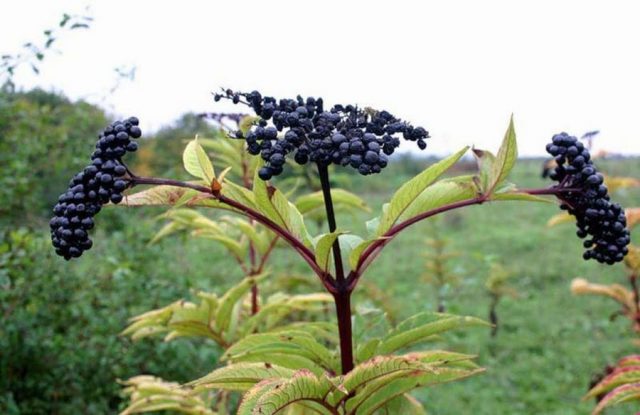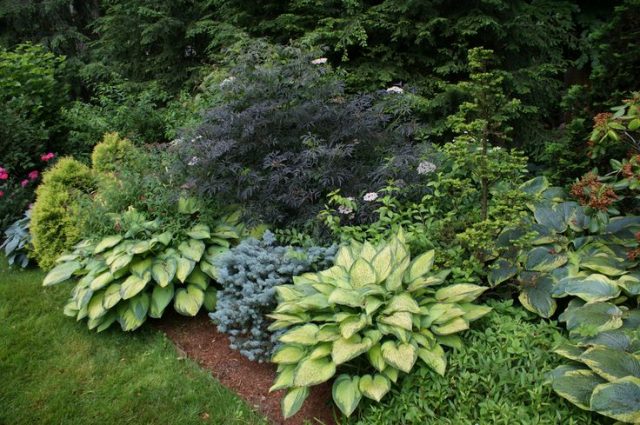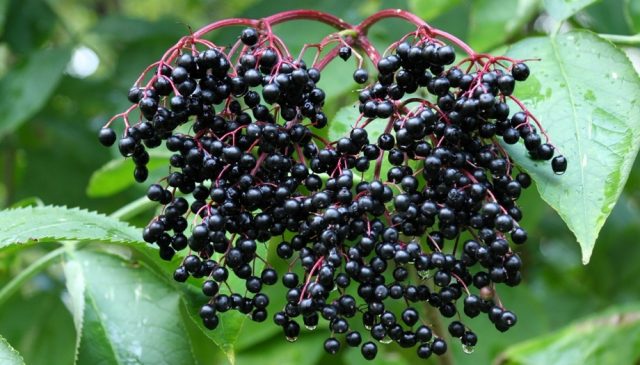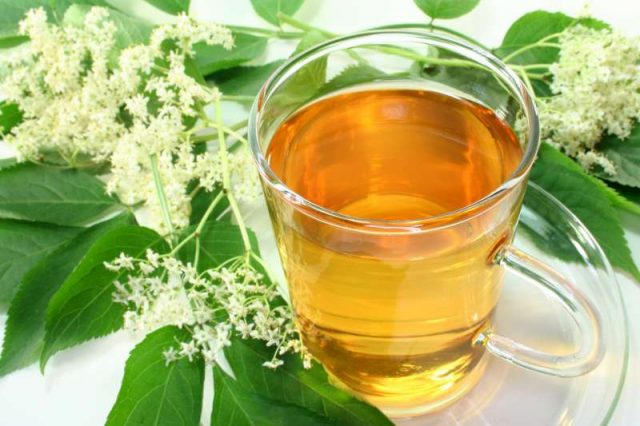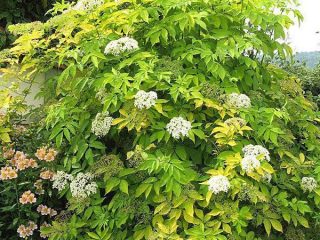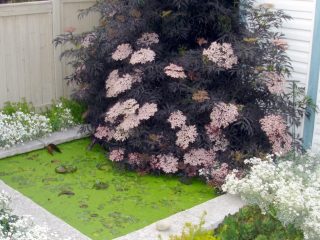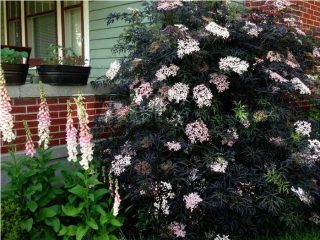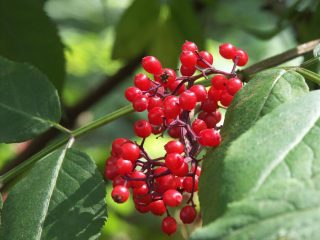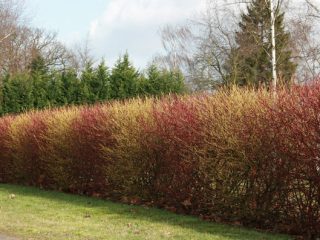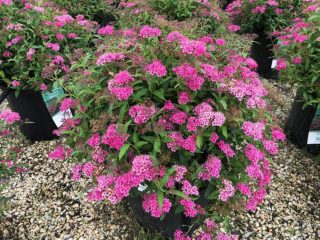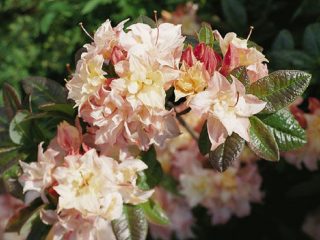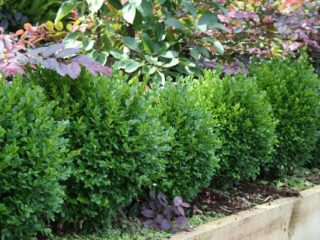Content
The description and medicinal properties of black elderberry are of great interest to fans of traditional medicine. This plant is often planted in areas not only for decorative, but also for medical purposes. To prevent the elderberry from doing harm, you should carefully study its features.
What does a black elderberry look like?
Of the many varieties of elderberry, black is the most common. It belongs to the Honeysuckle family, it is found most often in the form of a tall shrub with a wide dense crown. The maximum height of the shrub can be up to 10 m, however, in areas with a temperate climate, it often grows only up to 2-6 m.
According to the photo and description of the black elderberry, it is easy to recognize it by its brownish-gray branches and oval elongated green leaves with pointed ends. In May or early June, the shrub blooms with beautiful white or yellowish umbellate inflorescences, and its flowers exude a pleasant almond aroma. In August, the plant bears fruit - small dark purple berries with 2-3 seeds inside.
Is it possible to eat black elderberry
The fruits of black elderberry contain toxic substances that are dangerous to the human body. However, their concentration is low, much lower than in the red elderberry. Therefore, it is allowed to eat the fruits, but in minimal quantities, and it is even better to first subject them to heat treatment or dry them.
Where does the black elderberry grow
The plant is widespread throughout the world in the southern regions and in the middle lane. The black elderberry grows in Asia and North Africa, in the Caucasus and New Zealand and even in the Azores, you can find it in Georgia and Armenia, in Ukraine and Belarus, Moldova.
In Russia, the shrub is found in the southern regions of the European part - mainly in the Crimea and the Caucasus. As the photos confirm, the black elderberry grows almost everywhere, its favorite places are deciduous and coniferous forests, but the plant can also be found on wastelands, on roadsides and even in abandoned cemeteries.
In its natural habitat, elderberry can grow as a free-standing tree, but it also takes root well in shrubs. Moreover, the rapid growth of a plant leads to the fact that it itself often forms dense thickets.
When the black elderberry is harvested
The beneficial properties and contraindications of black elderberry are highly valued in folk medicine, while not only fruits, but also other parts are used for treatment. Therefore, the collection time depends on which part of the plant needs to be harvested.
- The fruits of the plant, which have the greatest benefit, are harvested during the period of natural ripening - in August, after the berries acquire a rich black-purple color.
- Flowers appear on the branches of the shrub in May or early June, and at this time they are collected, and it is not customary to cut off individual flowers, but the entire inflorescence with the help of a pruner.
- Leaves are also harvested in late spring or early summer, simultaneously with flowers - the younger the foliage, the more valuable substances it contains.
- The bark of the plant is harvested in the spring, before the beginning of the growing season, while the sap has not yet begun to move inside the elderberry, and the roots - in September, after the last fruits have been harvested.
For medicinal purposes, berries, flowers and leaves of black elderberry can be used fresh, but the roots are best dried in the sun or in the oven at a minimum temperature.
Black elderberry in landscape design + photo
Ornamental trees and shrubs of black elderberry are highly prized in landscaping. The plant is used in both large and small areas. In the first case, elderberry can complement tall garden trees, and in the second, replace them with itself, helping to decorate a small garden magnificently and expressively.
In private plots, in gardens and parks, black elderberry is used:
- to create natural and artistic hedges - several shrubs, planted side by side or next to other plants, reliably hide the territory from prying eyes;
- as a bright accent on empty plots or near blank walls of residential buildings;
- to repel insect pests and to eliminate unpleasant odors - elderberry not only pleases with its beautiful appearance, but also benefits, being located near compost heaps or latrines at a summer cottage.
In landscape design, the black elderberry shrub goes well with taller plants, as it emphasizes their slender forms and beauty. Equally often, the black elderberry is planted next to flower beds and undersized bushes, in this case it serves as the center of the artistic composition.
Another use for the shrub is to create a strong protective barrier next to fragile and weak plants. The shrub covers the area well from the wind, and if the garden is located near the road, it also stops the movement of polluted dusty air.
Planting and caring for a black elderberry
While the shrub thrives best in the southern regions, it also works very well for growing in temperate climates. In the middle lane, the black elderberry is unlikely to reach the maximum possible height, however, the cold climate will not affect the beauty of the plant and fruiting in any way.
The shrub is undemanding to lighting and can grow both in sunny and shaded areas. True, ornamental plant species in the shade lose their attractive color, so it is recommended to select places for them with a sufficient amount of sunlight.
Planting a black elderberry is easy enough, but you need to pay attention to the soil.
- The shrub prefers loose loam with a moderate level of moisture. In addition, soil fertility is very important for black elderberry - it cannot grow high enough on depleted soil. If the elderberry is planned to be planted precisely as an accent tall shrub, then a month before planting, compost and mineral fertilizers must be added to the soil.
- Shrub planting is carried out in spring or autumn, and seedlings that have reached 2 years of age are best used as planting material.
- A hole for planting a seedling is dug so that the root system of a young shrub is freely located in it. When deepening the plant, it is advisable to adhere to the same depth at which the shrub is used to growing.
Immediately after planting, it is recommended to prune the shrub a little, first removing diseased and dried branches, and water it properly.
Caring for a black elderberry can be considered quite simple; it does not require much effort from the gardener.
- Since the shrub prefers moderately moist soils, additional watering is rarely done - it is necessary to abundantly feed the black elderberry with moisture only during a drought.
- Plant feeding should be done only when the elderberry clearly stops growing and begins to weaken. Many gardeners simply prefer to mulch the trunk circle with manure or compost every year - the nutrient layer not only saturates the soil with useful substances, but also allows you to abandon the loosening and weeding of the soil.
- Black elderberry is usually cut for sanitary purposes once a year, in early spring - removal of dry and damaged branches is necessary in order to protect the shrub from diseases and pests. A decorative haircut can be carried out only once every 5 years, more often it is simply not required, although the elderberry recovers after pruning surprisingly quickly.
As for wintering, the black elderberry perfectly tolerates severe frosts and does not need shelter. Even if some of the shoots of the shrub freeze, with the beginning of the new growing season, the elderberry will quickly recover.
Why is black elderberry useful?
The medicinal properties of black elderberry are used in the treatment of dozens of various ailments, including very serious ones. However, the parts of the plant differ in chemical composition and therefore provide different benefits in home medicine.
The medicinal properties of black elderberry berries
The most useful part of the plant is its fruits, they contain a huge amount of vitamins, minerals, organic acids and antioxidants. The medicinal properties of black elderberry fruit help:
- for colds and high fever;
- with rheumatism and other inflammatory processes in the joints;
- with metabolic disorders and sluggish intestines;
- with problems with the outflow of bile and difficulty urinating;
- with pancreatitis, hepatitis and diabetes mellitus;
- with atherosclerosis and varicose veins.
On the basis of fresh and dried bush berries, a variety of healing agents are prepared: decoctions, infusions and alcoholic tinctures. Red elderberry jam has medicinal properties, it is not only tasty, but also healthy to use it with tea.
The benefits of black elderberry flowers
The flowers of the plant contain a lot of ascorbic acid, glycosides and essential oils, therefore they have strong anti-inflammatory properties. They are used most often in the form of infusions and decoctions in the treatment of influenza and cough, urological inflammation in men and cystitis in women.
In addition, decoctions and infusions of flowers can be added to medicinal baths - the plant also has a very beneficial effect on the skin.
Why is black elderberry root useful?
The roots of the bush contain tannins, saponins and bitterness, which gives the raw material anti-inflammatory, regenerating and rejuvenating properties. Dried elderberry roots are used for the preparation of medicinal drinks and are used in the treatment of atherosclerosis, high blood pressure. Root-based decoctions help with diabetes mellitus, as they can lower glucose levels.
Infusions and decoctions on the roots are beneficial for urogenital inflammation. And if you wipe the skin with healing agents, you can quickly get rid of irritations, scratches and ulcers.
Benefits of black elderberry leaves
The leaves of the plant contain an increased amount of ascorbic acid and carotene, essential oils and resins are also present in them. In folk medicine, black elderberry leaves are used to prepare pain relievers, healing and hemostatic agents.
A well-known decoction of the leaves of the plant in milk, such a remedy helps to quickly heal wounds, burns, diaper rash and sores on the skin.
What does the black elderberry heal?
Home medicine offers many effective recipes for treating mild symptoms and serious ailments. The properties of black elderberry become especially valuable in the fight against dangerous chronic diseases.
The use of black elderberry berries in oncology
Reviews of black elderberry for cancer claim that plant-based remedies are beneficial for cancer tumors, especially if foci of the disease are located in the stomach, prostate gland and prostate adenoma. A healing effect can be obtained if you use a tincture on the berries of a plant, and it is prepared as follows:
- the fruits of the black elderberry are washed, dried and grated or crushed in a blender, and then squeezed through cheesecloth to obtain fresh juice;
- elderberry juice in the amount of 3 liters is mixed in a glass jar with 500 g of granulated sugar, cover the neck of the jar with gauze and put away in a warm place for 3 days;
- the fermented tincture is poured into another vessel with a water seal - you can also use a punctured glove worn on the neck of a bottle or can;
- in this form, the tincture must be kept for another 2-3 weeks, until the primary fermentation ends.
You need to consume black elderberry tincture for cancer in small quantities - 50 ml three times a day on a full stomach. For better absorption, it is recommended to drink a glass of plain water shortly before taking the medicine. You need to continue treatment with black elderberry for 1.5 months, then you need to take a month break and, if necessary, continue therapy.
With uterine fibroids
Black elderberry increases immunity and general resistance to malignant processes in the body. It is useful to use plant-based products for women who are faced with uterine fibroids.
For the treatment of the disease, traditional medicine suggests using several means.
- First of all, you can use black elderberry syrup, it helps well with malignant and benign tumors. To prepare the medicine, it is necessary to tamp the fresh berries of the plant and sugar in layers in a small jar, and then insist for a month in the dark to get a sweet syrup. Take such a remedy in the amount of a large spoon 3 times a day.
- A decoction of dried berries is beneficial in the fight against fibroids. Pour about 30 g of fruit with a liter of hot water and boil on the stove, and then leave for half an hour and filter. You need to drink the broth three times a day on an empty stomach, only a quarter of a glass.
If a woman does not have alcohol intolerance, you can use a classic anti-cancer tincture on elderberry, for its preparation, 3 liters of elderberry juice is mixed with 500 g of sugar, kept in a warm place for 3 days, and then for 2-3 weeks it is insisted in a vessel with a water seal for high-quality fermentation. Take such a tincture of 50 ml on an empty stomach.
With diabetes mellitus
Herbal remedies based on black elderberry lower blood glucose levels and regulate insulin production. In diabetes mellitus, the plant can be of great benefit, in particular, traditional medicine values a decoction made from the roots. It is very simple to make it - a large spoonful of dried crushed raw materials are poured with a glass of hot water and boiled for half an hour over low heat.
You need to take the broth three times a day for 3-4 sips, this should be done on an empty stomach.Also, in case of illness, it is recommended to take baths with the addition of a decoction of flowers.
Women's health benefits
Black elderberry can be especially beneficial for the female body. First of all, the anti-inflammatory properties of the plant find their application in the treatment of gynecological ailments. Infusions and decoctions of black elderberry are used for rubbing, douching and sitting baths - the funds quickly relieve discomfort and eliminate infections.
Benefits of black elderberry for weight loss. If decoctions of fruits and flowers are used in small quantities during a diet, the plant will help speed up metabolism and thereby contribute to getting rid of excess weight. Baths with the addition of plant infusions not only have a strengthening effect on the body, but also tighten and rejuvenate the skin of the body.
It is impossible not to mention the use of elderberry fruits in cosmetology. Fresh berries, crushed to a state of gruel, when applied to the face, help get rid of acne and blackheads. And if you regularly wash your face with a decoction on the flowers of the plant, this will lighten the skin and eliminate freckles and age spots.
For joint diseases
The anti-inflammatory properties of the plant help with joint diseases - relieve pain, reduce swelling and improve mobility. Traditional medicine offers 2 main remedies.
- Medicinal collection for arthritis. Dried elder flowers and leaves, dry nettle and parsley root are mixed in equal amounts, and then 2 large spoons of the collection are measured out and brewed in 500 ml of boiling water for 20 minutes. You need to drink the broth four times a day, 100 ml shortly before eating.
- Infusion for gout. With inflammatory processes and salt deposits in the joints, another remedy helps - 5 large tablespoons of dried flowers are poured with a liter of hot water and left for 4 hours. After that, filter the infusion, and then drink half a glass twice a day on an empty stomach.
It is recommended to drink medicinal drinks based on black elderberry warm - this way they will be of great benefit.
Limitations and contraindications for admission
The properties of elderberry can have not only beneficial, but also harmful effects on the body. First of all, the raw berries of the plant should not be overused. And the root of the bush must be dried before use. When using infusions and decoctions, small dosages should be observed.
In addition, the black elderberry must be discarded:
- pregnant women;
- nursing mothers;
- in the acute phase of gastritis, stomach ulcers or pancreatitis;
- with Crohn's disease;
- in the presence of individual intolerance.
Reviews of black elderberry for children warn that only adolescents after 12 years of age can offer remedies from this plant - at an earlier age, home remedies will harm the child.
Conclusion
The description and medicinal properties of black elderberry allow us to conclude that in small quantities this plant is very useful for health and can help even with serious ailments. But an overdose of berries and other parts of the plant can be very harmful, and should not be allowed.

